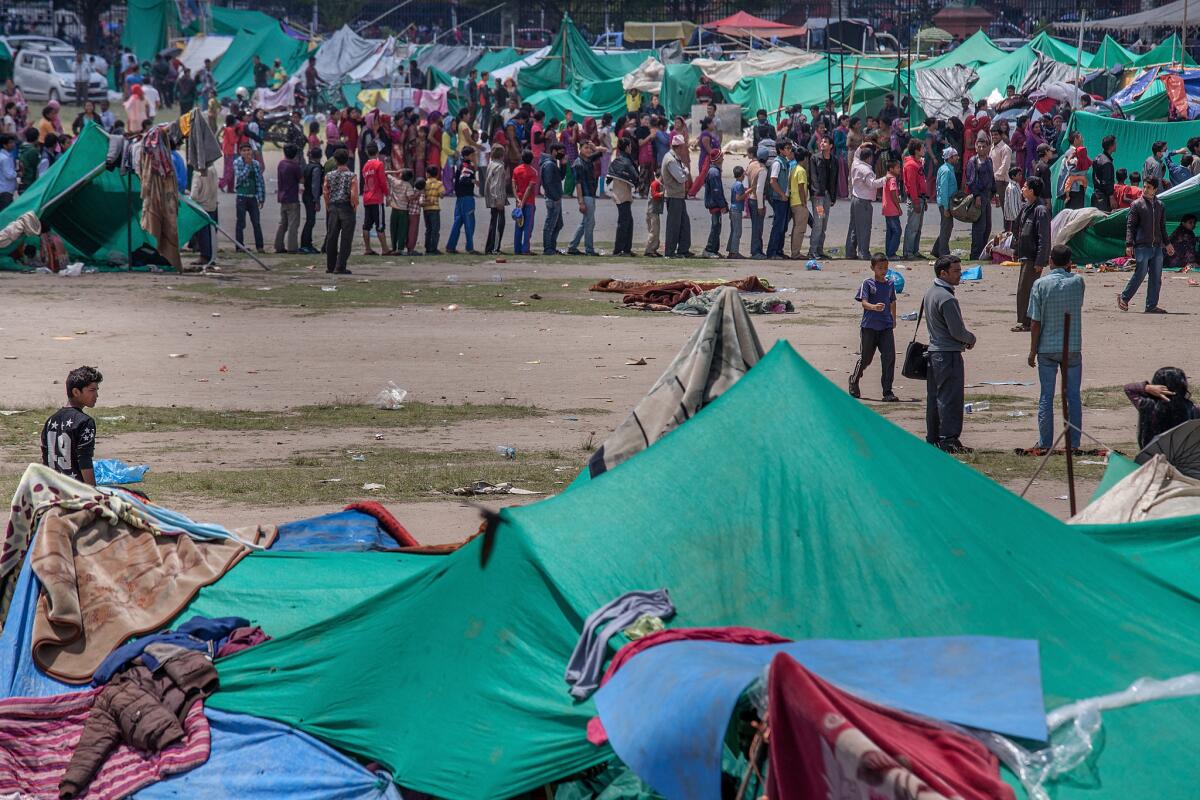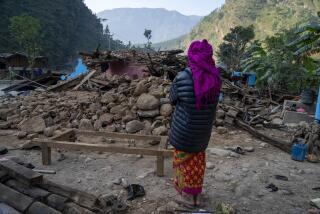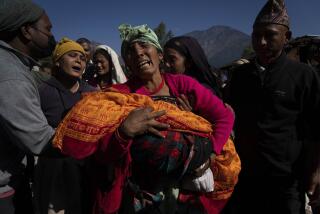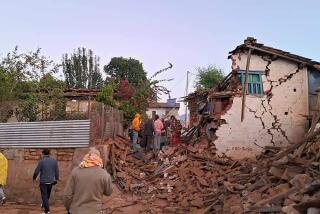Nepal quake: Tent city springs to life in Katmandu, transforming park

Residents line up for food in an evacuation area set up by the authorities in Tundhikel park in Katmandu, Nepal, on Monday.
- Share via
Reporting from Katmandu, Nepal — Sony Tamand was helping her aunt run her popular general store on Saturday afternoon when everything began to shake.
“I felt the ground moving from side to side and I just ran out of the store and onto the street screaming,” said Tamand, 20, a management major at Katmandu’s British College. “I only realized that it was a serious earthquake afterwards—it felt almost like a bad dream when it was happening.”
Tamand is part of a very large family, and she and her sisters and cousins find themselves part of an even larger community now, sleeping outdoors in central Katmandu, where thousands of displaced Nepali families have gathered in row after row of tents because their homes are either non-existent or unsafe.
“Everything is destroyed inside our home,” Tamand said of her family’s five-bedroom house. “My mother and father and my aunt, they had a talk on Sunday morning and said that we had to leave the house behind.”
On Monday afternoon, Tamand and six of her sisters and “cousin-sisters,” as she calls her cousins, tried to make the most of life in the new tent city. They sat in a circle, joking and gossiping, or eating instant noodles they made with boiled water.
In some ways, the afternoon felt not unlike an ordinary day off from school or work, Tamand said – except that on a normal holiday or weekend, the night would end with her being safe in her bed.
“Night time gets colder here,” Tamand’s 16-year-old sister Sunita said. “And it’s less safe to walk around than my home.”
The young women said that while most people living in the tent city are decent and helpful, there are some troublemakers from whom they would prefer to keep their distance.
“When night comes,” Sony Tamand said, “we stay close to the safety of our father and brothers.”
The tent city where the Tamands are staying is on a large, grassy rectangle known as Tundhikel, which serves as Katmandu’s Central Park and is where public festivals are traditionally held. Shortly after the earthquake struck on Saturday afternoon, families left homeless by the destruction were directed to Tundhikel by the Nepalese army.
It was only after the largest of many aftershocks, a magnitude 6.7 jolt on Sunday afternoon, that the entirety of the park became filled with tents.
Tents are in great demand throughout Katmandu, with many poorer families waiting in long lines just to receive tents from nongovernmental organizations such as the Red Cross or from the Indian army, which is in Nepal to help with earthquake relief.
At one point, in the Bagbazar Sadak neighborhood, residents mobbed an army jeep handing out tents made of plastic sheets. Eventually, the vehicle was forced to drive away to keep the crowd from getting out of control.
“Nowhere in this city is safe,” said Sagar K.C., 33, a volunteer for the Red Cross who was in Bagbazar Sadak at the time of the incident.
The tent city might be the closest thing to security in such a chaotic time.
When a small aftershock hit around 9:30 p.m. Monday, screams pierced the darkness, but many people remained calm. Among them was Rasan Thama, 27, a laborer, who brought his family to the camping ground at Tundhikel to escape the danger of objects falling on them at home during an aftershock.
“You see? It’s time for earthquakes,” Thama said, pointing to his daughter, Rana Thama, 9, who was huddled safely against her mother, wearing a maroon winter coat. “It’s better to be here where it’s safe.”
But for how long? For Sony Tamand and her family, the tent city represents home for the foreseeable future.
“Right now we’re together and I’m happy,” Tamand said of life in Tundhikel. “For me, it’s better not to think about the future right now.”
Hayden is a special correspondent.
More to Read
Sign up for Essential California
The most important California stories and recommendations in your inbox every morning.
You may occasionally receive promotional content from the Los Angeles Times.













